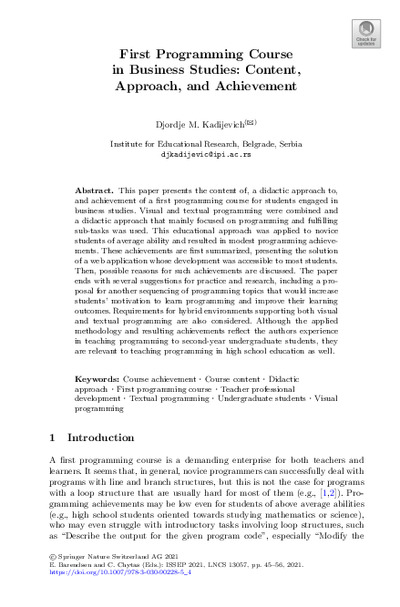First Programming Course in Business StudiesContent, Approach, and Achievement
Djordje M. Kadijevich
|
 |
 Diese Seite wurde seit 1 Jahr inhaltlich nicht mehr aktualisiert.
Unter Umständen ist sie nicht mehr aktuell.
Diese Seite wurde seit 1 Jahr inhaltlich nicht mehr aktualisiert.
Unter Umständen ist sie nicht mehr aktuell.
 Zusammenfassungen
Zusammenfassungen
 This paper presents the content of, a didactic approach to, and achievement of a first programming course for students engaged in business studies. Visual and textual programming were combined and a didactic approach that mainly focused on programming and fulfilling sub-tasks was used. This educational approach was applied to novice students of average ability and resulted in modest programming achievements. These achievements are first summarized, presenting the solution of a web application whose development was accessible to most students. Then, possible reasons for such achievements are discussed. The paper ends with several suggestions for practice and research, including a proposal for another sequencing of programming topics that would increase students’ motivation to learn programming and improve their learning outcomes. Requirements for hybrid environments supporting both visual and textual programming are also considered. Although the applied methodology and resulting achievements reflect the authors experience in teaching programming to second-year undergraduate students, they are relevant to teaching programming in high school education as well.
This paper presents the content of, a didactic approach to, and achievement of a first programming course for students engaged in business studies. Visual and textual programming were combined and a didactic approach that mainly focused on programming and fulfilling sub-tasks was used. This educational approach was applied to novice students of average ability and resulted in modest programming achievements. These achievements are first summarized, presenting the solution of a web application whose development was accessible to most students. Then, possible reasons for such achievements are discussed. The paper ends with several suggestions for practice and research, including a proposal for another sequencing of programming topics that would increase students’ motivation to learn programming and improve their learning outcomes. Requirements for hybrid environments supporting both visual and textual programming are also considered. Although the applied methodology and resulting achievements reflect the authors experience in teaching programming to second-year undergraduate students, they are relevant to teaching programming in high school education as well. Dieser wissenschaftliche Zeitschriftenartikel erwähnt ...
Dieser wissenschaftliche Zeitschriftenartikel erwähnt ...
 Personen KB IB clear | Michal Armoni , Michael E.Caspersen , Tamar Benaya , Jens Bennedsen , John M. Carroll , David Ginat , Felienne Hermans , Peter Hubwieser , David H. Jonassen , Lutz Kohl , Michael Kölling , Anna Beata Kwiatkowska , Marileen Smit , Alaaeddin Swidan , Maciej M. Syslo , Péter Szlávi , László Zsakó , Ela Zur | ||||||||||||||||||||||||||||||||||||||||||||||||||||||||||||||||||||||||
 Begriffe KB IB clear |  Lernen Lernen learning
, learning
,  Motivation Motivation motivation
, motivation
,  Programmieren Programmieren programming programming
| ||||||||||||||||||||||||||||||||||||||||||||||||||||||||||||||||||||||||
 Bücher |
| ||||||||||||||||||||||||||||||||||||||||||||||||||||||||||||||||||||||||
 Texte |
|
 Zitationsgraph
Zitationsgraph
 Zitationsgraph (Beta-Test mit vis.js)
Zitationsgraph (Beta-Test mit vis.js)
 Zeitleiste
Zeitleiste
 1 Erwähnungen
1 Erwähnungen 
- Teaching Coding in K-12 Schools - Research and Application (Therese Keane, Andrew Fluck) (2023)


- Applying Hybrid Programming in High Schools - An Empirical Study Analysing Teachers’ Opinions (Djordje M. Kadijevich) (2023)


- Applying Hybrid Programming in High Schools - An Empirical Study Analysing Teachers’ Opinions (Djordje M. Kadijevich) (2023)
 Anderswo finden
Anderswo finden
 Volltext dieses Dokuments
Volltext dieses Dokuments
 |  First Programming Course in Business Studies: Content, Approach, and Achievement: Artikel als Volltext @ Springer ( First Programming Course in Business Studies: Content, Approach, and Achievement: Artikel als Volltext @ Springer ( : :  , 989 kByte; , 989 kByte;  : :  ) ) |
 Anderswo suchen
Anderswo suchen 
 Beat und dieser wissenschaftliche Zeitschriftenartikel
Beat und dieser wissenschaftliche Zeitschriftenartikel
Beat hat Dieser wissenschaftliche Zeitschriftenartikel während seiner Zeit am Institut für Medien und Schule (IMS) ins Biblionetz aufgenommen. Beat besitzt kein physisches, aber ein digitales Exemplar. Eine digitale Version ist auf dem Internet verfügbar (s.o.). Es gibt bisher nur wenige Objekte im Biblionetz, die dieses Werk zitieren.



















 Biblionetz-History
Biblionetz-History